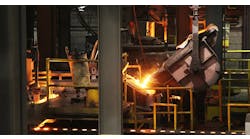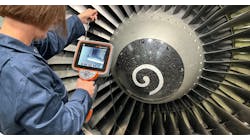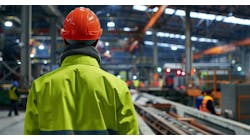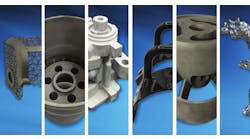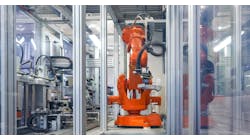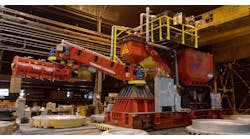How Intelligent is Your Borescope?
Top Investment Castings of 2024
Sinto America Adding Tinker Omega
Organize, Manage Work Instructions
Re-Evaluating the Value of AI
The world appears determined to finde sustainable, low-carbon solutions for transportation, which more than any other factor is guiding the drive to hybrid electric vehicle (HEV) and battery electric vehicle (BEV) development and production.
According to Automotive News and a study by Boston Consulting Group, electrified vehicle sales (mild hybrid, full hybrid, plug-in hybrid and full battery-electric vehicles) are expected to surpass internal-combustion-engine [ICE] vehicle sales by 2030, taking 51% of the market; with BEV and PHEV (plug-in hybrid electric vehicle) categories accounting for abut 25% of total vehicle sales. However, 82% of cars still will contain an ICE powertrain, with PHEVs, HEVs, and mild hybrids all using internal combustion engines alongside their electric powertrain.
Automotive manufacturers are under pressures from many sides. On the consumer side, there is a sharp drop in confidence in diesel engines due to the introduction of clean air zones, some of which are already in force, along with pending bans on internal combustion engine vehicles (e.g., in California and in the U.K. by 2035.)
Meanwhile, governments around the world are tightening up on automotive emission legislation. In Europe, there are increasingly stringent CO2-emission regulations. In China, Corporate Average Fuel Consumption (CAFC) and New-Energy Vehicle (NEV) regulations are growing progressively stricter.
To address both regulations and consumer needs, automakers are preparing a wave of new electric vehicle (EV) models during 2020. Many EVs on the market in recent years have been targeted at high-end markets, with matching price tags. However, in 2020 we’ve seen the launch of EVs that are much more familiar and accessible to the average driver, including the MINI, the Vauxhall Corsa, the Fiat 500, and the Volkswagen ID.3 and e-Up!, just a few to mention.
While significant advances already have been achieved in hybrid and BEV manufacturing, it is increasingly important for the engineering and manufacturing processes behind them also to be environmentally sustainable.
Vacuum impregnation in automotive manufacturing — With vehicle weight having an adverse effect on battery usage, hybrid and BEV manufacturers increasingly look for ways to reduce overall vehicle mass. Using diecast structural components can help — especially if manufacturers opt to substitute materials like steel with lightweight materials like aluminum. By manufacturing drive and powertrain components (e.g., electric motors) from diecast aluminum, automakers can further reduce vehicle weight. In turn, battery range can be extended for BEVs and HEVs, while reducing vehicle emissions for the latter, too.
However, porosity is a longstanding an issue with castings. As well as surface imperfections, microscopic holes may form within a part during casting and solidification, meaning it may develop leak paths that degrade its performance in the destined application.
In applications with requirements to be pressure or fluid-tight, for example in the complex cooling functions of hybrid and BEV drive systems, this can be an especially critical issue. The move toward thinner walled castings for powertrain components to reduce component weight also brings an increased risk of porosity. All this makes vacuum impregnation even more vital, to avoid scrapping complex and high-value components once the work order has been secured and the parts have been produced.
Vacuum impregnation offers an OEM approved method for sealing leak paths and porosity in metalcastings, sintered metal parts, and electrical components. Using specialist impregnation equipment, voids are filled with a liquid sealant under vacuum, which then turns into a chemically and thermally resistant polymer by heating in a hot-cure process. For hybrid and BEV manufacturing, vacuum impregnation can effectively seal diecast and electronic parts against leakage or fluid ingress.
As well as improving the reliability of components, the process reduces scrappage and lowers defect rates, in turn reducing waste and costs from the manufacturing process.
Operational considerations — With supply chains under increasing economic pressure, treating porosity becomes even more important. Scrapping fully machined parts is expensive, given the work invested in them, however if a machined part fails after it has been incorporated into a component (an automotive compressor, for example) then the costs associated with scrapping become significantly higher.
For this Ultraseal offers a range of equipment that can be incorporated into any production line, and both impregnation services managed in-house or off-site. Modern, front-loading impregnation systems offer users speed, control, and significant health-and-safety advantages, as well as a small footprint and the low cost of ownership.
For higher-volume requirements, automated production equipment offers significantly reduced production and labor costs and lower operator involvement. These fully automated systems combine fast, consistent cycle times with best-in-class sealing performance, ensuring consistent output quality and health-and-safety improvements.
To maximize uptime and reduce the overall cost of ownership, Ultraseal’s team can remotely monitor the performance and operating history of the equipment, helping to optimize processes and minimize unplanned downtime. Finally, those who don’t have the need or space for a dedicated impregnation process in-house can access a global network of operations to manage the process, start to finish, or opt for fully managed on-site service with cost-effective, end-to-end, impregnation process management without investing in capital equipment or personnel.
Recycling, sustainability considerations — In a traditional impregnation process, components are placed into an autoclave, where they are immersed in sealant and a vacuum is used to draw the sealant into micro-porosities and leak paths. A cold-wash module then removes excess sealant and a hot-cure cycle exposes components to heat, which polymerizes the sealant, changing it from a liquid state to solid polymer.
During the cold-wash part of this process, up to 98% of the sealant used becomes waste. To avoid this expense and meet increasingly stringent environmental guidelines, Ultraseal offers a range of recyclable sealants. Instead of being washed away, the sealant is collected and passed through a sealant recovery system, for reuse. As well as a significant reduction in sealant consumption, the process uses significantly less water and removes the need to change wash-water tanks, significantly reducing downtime and improving process efficiency.
Ultraseal also can convert existing systems to use Ultraseal’s recycling sealants. This helps to meet environmental regulations and reduce waste without the need to invest in completely new systems.
Incorporating vacuum impregnation into manufacturing processes can automakers and their casting suppliers to reduce scrap and material waste, improving component lifecycles and environmental performance.
Dr. Mark Cross is the commercial sales director at Ultraseal International. Learn more at www.ultraseal-impregnation.com.

